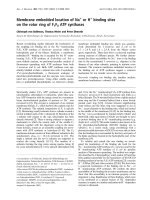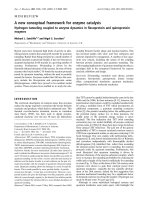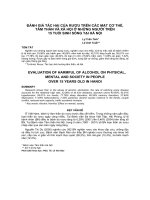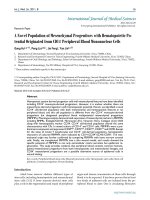Báo cáo y học: "Fully-spliced HIV-1 RNAs are reverse transcribed with similar efficiencies as the genomic RNA in virions and cells, but more efficiently in AZT-treated cells" ppt
Bạn đang xem bản rút gọn của tài liệu. Xem và tải ngay bản đầy đủ của tài liệu tại đây (237.74 KB, 6 trang )
BioMed Central
Page 1 of 6
(page number not for citation purposes)
Retrovirology
Open Access
Short report
Fully-spliced HIV-1 RNAs are reverse transcribed with similar
efficiencies as the genomic RNA in virions and cells, but more
efficiently in AZT-treated cells
Laurent Houzet, Zakia Morichaud and Marylène Mougel*
Address: CPBS, UMI, CNRS, 4 bd Henri IV, CS 69033, 34965 Montpellier, France
Email: Laurent Houzet - ; Zakia Morichaud - ;
Marylène Mougel* -
* Corresponding author
Abstract
We have shown previously that HIV actively and selectively packages the spliced HIV RNAs into
progeny virions. In the present study, by using a RT-QPCR and QPCR strategies, we show that
spliced viral RNAs are present in infectious particles and consequently participate, along with the
unspliced genomic RNA, to some of the early steps of infection such as the reverse transcription
step. This work provides the first quantitative data on reverse transcription of the fully spliced viral
RNAs, also called the early transcripts, in target cells but also inside virions. The latter results were
obtained by measuring the natural endogenous reverse transcription activity directly on intact HIV-
1 particles. Our study reveals that spliced HIV RNAs are reverse transcribed as efficiently as the
genomic RNA, both in cells and virions. Interestingly, we also show that reverse transcription of
spliced RNAs is 56-fold less sensitive to the inhibitor AZT than reverse transcription of the
genomic RNA. Therefore, the selection mediated by inhibitors of reverse transcription used to
treat patients could lead to increased representativeness of spliced forms of HIV, thus favoring
recombination between the HIV DNA species and facilitating HIV recovery.
Findings
HIV particles include two-copies of full-length genomic
RNA (FL RNA) which represent less than 50% of the RNA
mass in virions [1]. Indeed, HIV also packages viral
spliced and cellular RNAs. Recently, in a detailed quanti-
tative study, we showed that both singly and fully spliced
viral RNAs are packaged with similar efficiencies into HIV-
1 particles and by an active mechanism dependent of the
FL RNA packaging [2]. Assuming that spliced HIV RNAs
are packaged in infectious particles, we postulated that
they are actively involved in some of the early stages of
infection such as the reverse transcription (RTion) step. By
using extensive QPCR strategies (well described in [2]),
we investigated the fate of the spliced viral RNAs in HIV-1
infected cells, more specifically during RTion. We focused
on the fully spliced (FSpl) RNAs because they represent
the majority of the HIV-1 spliced transcripts and because
they encode the regulatory proteins Tat, Rev and Nef,
required to engage infection.
Fully-spliced HIV RNAs are reverse transcribed
as efficiently as the FL RNA within infected cells
Reverse transcription requires cis-acting elements of the FL
RNA template including the Primer Binding Site (PBS)
used for RTion initiation, the 5'R and 3'R regions,
required for template switching, and the polypurine tracts
Published: 2 May 2007
Retrovirology 2007, 4:30 doi:10.1186/1742-4690-4-30
Received: 28 March 2007
Accepted: 2 May 2007
This article is available from: />© 2007 Houzet et al; licensee BioMed Central Ltd.
This is an Open Access article distributed under the terms of the Creative Commons Attribution License ( />),
which permits unrestricted use, distribution, and reproduction in any medium, provided the original work is properly cited.
Retrovirology 2007, 4:30 />Page 2 of 6
(page number not for citation purposes)
(PPTc and PPT3') used for plus-strand DNA synthesis
priming (Fig. 1) [3]. All these elements, except for the
PPTc, are maintained within all spliced RNAs since the 5'
major splice-donor site (SD1) is located downstream of
the PBS (Fig. 1). This raises the possibility that virions-
associated spliced RNAs may be reverse transcribed during
viral replication.
To address this issue, the stably CD4/CXCR4-coexpressing
HEK-293 cells (42CD4) [4] were infected with HIV stocks
produced by 293T cells previously transfected with the
pNL4.3 plasmid [2]. After 24 h of infection, total cellular
DNA was extracted and subjected to specific QPCR analy-
sis. Under these settings, the effects of potential reinfec-
tion on RT efficiencies are not significant. First, we used
primers allowing detection of the viral cDNA species from
the earliest steps of RTion, i.e. the minus strong-stop DNA
synthesis (ssDNA) and the first strand transfer (repre-
sented by the U3 product) (Fig. 1). Up to now, there is no
data available on spliced viral RNA RTion efficiency in
HIV-1 infected cells. To specifically quantify the overall
"FSpl cDNA" forms we used a primer pair (FSpl) specific
for the SD4/SA7 exon-exon junction [2] (Fig. 1). For com-
parative purposes, production of proviral DNA (FL) was
also measured with a primer pair (FL) targeting the gag
gene. All these primer pairs gave similar PCR reliability
when used with pNL4.3 plasmid as a control template
(Fig. 2). The plasmid DNA contamination arising from
the pNL4-3 transfection used to produce virion stocks,
was monitored by using a primer pair (pNL) specific for
Schematic representation of templates, primers and products of RTion reactionsFigure 1
Schematic representation of templates, primers and products of RTion reactions. Only the 2 splice donor sites
(SD1 and SD4) and the 2 splice acceptor sites (SA5 and SA7) important for this study are indicated. PCR-primer pairs used to
specifically quantify the pNL4.3 plasmid (pNL), the FL cDNA or RNA (FL), and the Fspl cDNAs or RNAs (FSpl) are in gray,
blue and red, respectively. Final proviral products corresponding to RTion of FL and FSpl RNAs are presented. RTion is a
multi-step process and for clarity purposes, only the shortest intermediate RTion products detected with primer pairs specific
for FL and FSpl are presented, as well as the shortest common ssDNA (yellow) and the U3 intermediate (green), respectively.
All primer sequences and detailed PCR conditions will be provided on request.
SD1/SA5
SD4 SA7
PBSU3 U5R gag env U3 U5R
pNL4.3
pNL4.3
SD1 SA5
SD4/SA7SD1/SA5
FSpl RNA
SD4/SA7
PBSU5R U3 R
SD4 SA7
PBSU5R
gag env
U3 R
SD1 SA5
FL RNA
ssDNA
ssDNA
PBSU3 U5R
gag
env U3 U5R
cDNA
ssDNA
ssDNA
U3
U3
PBSU3 U5RU3U5R
cDNA
U3
U3
PPT3’
PPT3’
PPT3’
PPTc
PPTc
Retrovirology 2007, 4:30 />Page 3 of 6
(page number not for citation purposes)
the pNL4.3 plasmid but not for HIV FL proviral DNA (Fig.
1) and was less than 2% (Fig. 2). Control amplifications
on mock-infected cells with primer combinations specific
for the ssDNA, U3, FL or Fspl RNAs gave only low unspe-
cific background signal (Fig. 2). As expected, proviral
DNA (FL) was mainly amplified in DNA extracted from
infected cells (3.8 × 10
6
cps) since virions majoritarily
contained FL RNA. Since the amounts detected with either
the ssDNA or the U3 primers were close to 2-times of
those measured with the FL primers, they mostly corre-
spond to the entire FL cDNA. However, additional cDNA
species corresponding to the RTion of FSpl RNAs, and pre-
sumably to the entire spliced proviral forms as previously
shown by [5], were detected in infected cells and were 44-
fold less abundant than FL cDNA (Fig. 2).
To determine the RTion efficiencies of the FL and FSpl
RNA species, we also quantified the corresponding RNA
levels contained in the infecting virus stocks. The pNL4-3
copy numbers were subtracted from the FL DNA amount
and we calculated the ratios of DNA amount in cells/RNA
template level in infecting particles (Fig. 3). These results
show that FL and FSpl RNAs are both packaged in infec-
tious HIV particles and subsequently reverse transcribed
in infected cells with similar efficiencies, suggesting that
the HIV RTion machinery does not discriminate between
these two templates and that their RTion is regulated by
the same mechanism.
Reverse transcription of spliced RNAs is less
sensitive to AZT than RTion of the FL RNA
Reverse transcription of FL RNA is inhibited in the pres-
ence of AZT, an inhibitor of the reverse transcriptase (RT)
widely used in the clinic for the treatment of HIV infec-
tion. AZT, after conversion to AZT-5'-triphosphate by cel-
lular enzymes, inhibits RT through a competition with the
natural dTTP [6]. To further investigate the RTion of
spliced RNAs, we examined its sensitivity to AZT (Fig. 4).
The 42CD4 cells were pretreated 3 h before infection with
10 μM AZT and infection was pursued for 24 h in the pres-
ence of 10 μM AZT. After DNA extraction, cDNA was
quantified as before. As expected, the AZT treatment
Quantitative analysis of reverse transcription of spliced and unspliced HIV RNAs within infected cellsFigure 2
Quantitative analysis of reverse transcription of spliced and unspliced HIV RNAs within infected cells. The dif-
ferent RTion products were quantified in 25ng of cellular DNA samples and results derived from standard curves realized with
pNL4.3 dilutions, were expressed as copy numbers (cps) in 10
5
cells. The GAPDH gene was monitored to control the input of
cellular genomic DNA samples used in each assay. Reliability and specificity of the QPCR amplifications are illustrated with 5 ×
10
5
cps of pNL4.3 plasmid. Since U3 and ssDNA targets occur twice in the pNL4.3 plasmid used for standard curve, the meas-
ured cps were multiplied by 2 to obtain the real number of target sequences in the corresponding sample. Results represent
mean standard ± deviations of at least three independent experiments.
HIV Mock HIV Mock HIV Mock HIV Mock
pNL
ssDNA
FSpl
GA pNL FL FSpl
GA pNL FL FSpl
Primer:
plasmid DNA
DNA produced in 10
5
cells
HIV Mock HIV Mock
U3 FL
ssDNA
ssDNA
U3 U3
10
3
10
4
10
5
10
6
10
7
DNA copy numbers
10
8
Retrovirology 2007, 4:30 />Page 4 of 6
(page number not for citation purposes)
induced a strong decrease (185-fold) of the FL cDNA
amounts in infected cells. In contrast, AZT induced only a
3-fold decrease of the "spliced cDNA" synthesis (Fig. 4).
At least two non-exclusive hypothesis could explain this
resistance of FSpl RTion to AZT, either the reduced
number of AZT sites within short template or the achieve-
ment of RTion before the cell entry, as NERT, then escap-
ing the AZT treatment.
The mechanism of AZT inhibition has been well studied
both in vitro [7] and in infected cells [8], showing that
inhibition occurred most efficiently when the DNA prod-
ucts of RT reaction were long. Note that FSpl RNAs are
more than 4-fold shorter than FL RNA. We also measured
the effects of AZT on intermediate-length reverse-tran-
scribed DNA products, such as the minus ssDNA and U3
cDNA (Fig. 1). As shown in Fig. 4, and similarly to "Fspl
cDNA", AZT has only little effect on the synthesis of these
two short RTion intermediates.
This result suggests that in the infected cells exposed to
AZT, the high level of the "FSpl cDNAs" is a direct conse-
quence of their short length.
Reverse transcription of FL and FSpl RNAs is
achieved equally in intact virions
NERT activity has been reported previously in non-perme-
abilized HIV-1 virions and constitutes a real potential tar-
get for the development of lentivirucides [9]. Because
RTion of the FSpl RNAs might also escape the AZT inhibi-
tion through a higher NERT activity than FL RNA before
cell infection, we therefore searched for HIV cDNA forms
in HIV-1 particles. Thus, we compared the relative NERT
efficiencies between FL and FSpl RNAs (Fig. 5A).
In these experiments, the pelleted virions were incubated
with DNase at 37°c for 45 min. This step was crucial to
reduce the pNL4-3 plasmid contamination under the level
of the FL cDNA. First, we evaluated the abundance of the
early reverse-transcribed intermediates, ssDNA and U3,
that showed similar and significant intravirion amounts
(Fig. 5A), demonstrating the presence of NERT activity in
the HIV-1 progeny. Similar experiments were then con-
ducted with primers specific for FL and FSpl cDNA and
showed that FL RTion products were more abundant than
"Fspl cDNA" forms. NERT efficiencies (Fig. 5B) were then
calculated as ratios of intravirion DNA and intravirion
RNA ((DNA/RNA) × 100). These results revealed that FSpl
RNAs were reverse transcribed inside virions with similar
efficiencies as FL RNA (0.06% and 0.1%, respectively) and
definitively not with higher efficiencies.
The relative abundance of FSpl RTion products in infected
cells (1 FSpl for 44 FL) favors the hypothesis of a possible
role in early steps of infection. Interestingly, it was previ-
ously reported that the FL cDNA was expressed as a non-
integrated form at the very beginning of infection to give
FL RNA and spliced RNAs ([10,11], for review see [12] and
references herein). Our results suggest that spliced RNAs
could also arise from direct expression of their non-inte-
grated cDNAs. Such early transcriptional activity from
non-integrated DNAs could be highly significant in HIV-1
infection since all protein products of the FSpl RNAs are
particularly crucial to engage infection. Altogether, these
packaging and RTion abilities harbored by the spliced
RNAs along with their low sensitivity towards RTion
inhibitor, could bring first elements to explain the recent
observation of high amounts of FSpl RNAs in virions iso-
lated from plasma of AIDS patients under highly active
antiretroviral therapy [13]. Indeed, the selection mediated
by RTion inhibitors used to treat patients could lead to
increased proportion of spliced forms of HIV RNAs and
cDNAs, and consequently to unusual encapsidation lev-
els. This could increase recombination events between
spliced and FL DNAs [5]. These results should also be con-
sidered with respect to gene therapy protocols that com-
monly used HIV-producer cells with replication-defective
vectors derived from HIV [14]. Indeed, in these systems
using Psi-minus genomic RNA, encapsidation of spliced
Apparent RTion efficiencies of FL and FSpl RNAs in HIV-1 infected cellsFigure 3
Apparent RTion efficiencies of FL and FSpl RNAs in HIV-1
infected cells.
2.3
2
0
0.5
1
1.5
2
2.5
3
3.5
FL FSpl
(DNA in cell/RNA in virion)x100
Retrovirology 2007, 4:30 />Page 5 of 6
(page number not for citation purposes)
Relative effects of AZT on different RTion products within infected cellsFigure 4
Relative effects of AZT on different RTion products within infected cells. The copy numbers (cps) were measured in
25ng of DNA extracted from cells treated or not with AZT and ratios were calculated as: (+AZT/-AZT) × 100. For each
cDNA species, levels were average (± SD) from at least three independent experiments and normalized to level measured
without AZT.
0.54
42.3
35.3
30.3
0,1
1
10
100
-
FL FSpl
AZT:
+
-
+
FL FSpl ssDNA U3
-
+
-
+
ssDNA U3
Primer:
Relative AZT effects
Quantitative analysis of NERTFigure 5
Quantitative analysis of NERT. (A) Intravirion DNA copy numbers quantified in virion samples corresponding to100ng of
HIV p24. The DNAse treatment of virus particles lead to a plasmid DNA contamination reduced to 25%. (B) Comparison of
NERT efficiencies between FL and FSpl RNAs. Results represent mean ± standard deviation.
(A) (B)
0.06
0.1
0
0.02
0.04
0.06
0.08
0.10
0.12
0.14
FL FSpl
intravirion (DNA/RNA) x100
8.7x10
3
1.2x10
5
1x10
5
3.6x10
4
5x10
2
pNL ssDNA U3 FL FSpl
10
10
2
10
3
10
4
10
5
intravirion DNA copy numbers
10
6
Publish with BioMed Central and every
scientist can read your work free of charge
"BioMed Central will be the most significant development for
disseminating the results of biomedical research in our lifetime."
Sir Paul Nurse, Cancer Research UK
Your research papers will be:
available free of charge to the entire biomedical community
peer reviewed and published immediately upon acceptance
cited in PubMed and archived on PubMed Central
yours — you keep the copyright
Submit your manuscript here:
/>BioMedcentral
Retrovirology 2007, 4:30 />Page 6 of 6
(page number not for citation purposes)
viral RNAs is drastically enhanced [2] and subsequent
RTion of those RNAs would enable the recombination
between FL and spliced forms and thus the infectious HIV
recovery.
Abbreviations
HIV-1, human immunodeficiency virus type 1, FL, full-
length, FSpl, fully spliced, cps, copy numbers,, RTion,
reverse transcription, RT, reverse transcriptase, AZT, Zido-
vudine, NERT, natural endogenous reverse transcription.
Competing interests
The author(s) declare that they have no competing inter-
ests.
Authors' contributions
LH and MM have conceived the study and analyzed data.
LH performed the laboratory work with ZM help, and
helped in drafting and finalizing the manuscript. MM
wrote the manuscript. All authors read and approved the
final manuscript.
Acknowledgements
The authors thank M. Biart for the 42CD4 cell-line and laboratory mem-
bers past and present, including S. Maurel and F. Smagulova for helpful dis-
cussion. We also thank C. Isel for critical reading of the manuscript. This
work was supported by the CNRS, SIDACTION, ANRS and the Ministère
de la Recherche (ACI) to MM. LH was supported by a fellowship from
SIDACTION.
References
1. Muriaux D, Rein A: Encapsidation and transduction of cellular
genes by retroviruses. Front Biosci 2003, 8:D135-142.
2. Houzet H, Smagulova F, Paillart J, Maurel S, Morichaud Z, Marquet R,
Mougel M: HIV controls the selective packaging of genomic,
spliced viral, and cellular RNAs into virions through different
mechanisms. Nucleic Acids Res 2007. sous presse
3. Gotte M, Li X, Wainberg MA: HIV-1 reverse transcription: a
brief overview focused on structure-function relationships
among molecules involved in initiation of the reaction. Arch
Biochem Biophys 1999, 365:199-210.
4. Biard-Piechaczyk M, Robert-Hebmann V, Richard V, Roland J, Hip-
skind RA, Devaux C: Caspase-dependent apoptosis of cells
expressing the chemokine receptor CXCR4 is induced by
cell membrane-associated human immunodeficiency virus
type 1 envelope glycoprotein (gp120). Virology 2000,
268:329-344.
5. Liang C, Hu J, Russell RS, Kameoka M, Wainberg MA: Spliced
human immunodeficiency virus type 1 RNA is reverse tran-
scribed into cDNA within infected cells. AIDS Res Hum Retrovi-
ruses 2004, 20:203-211.
6. Papadopulos-Eleopulos E, Turner VF, Papadimitriou JM, Causer D,
Alphonso H, Miller T: A critical analysis of the pharmacology of
AZT and its use in AIDS. Curr Med Res Opin 1999, 15(Suppl
1):S1-45.
7. Quan Y, Liang C, Inouye P, Wainberg MA: Enhanced impairment
of chain elongation by inhibitors of HIV reverse transcriptase
in cell-free reactions yielding longer DNA products. Nucleic
Acids Res 1998, 26:5692-5698.
8. Quan Y, Rong L, Liang C, Wainberg MA: Reverse transcriptase
inhibitors can selectively block the synthesis of differently
sized viral DNA transcripts in cells acutely infected with
human immunodeficiency virus type 1. J Virol 1999,
73:6700-6707.
9. Zhang H, Dornadula G, Pomerantz RJ: Natural endogenous
reverse transcription of HIV type 1. AIDS Res Hum Retroviruses
1998, 14(Suppl 1):S93-95.
10. Brussel A, Sonigo P: Evidence for gene expression by uninte-
grated human immunodeficiency virus type 1 DNA species.
J Virol 2004, 78:11263-11271.
11. Wu Y, Marsh JW: Selective transcription and modulation of
resting T cell activity by preintegrated HIV DNA. Science
2001, 293:1503-1506.
12. Wu Y: HIV-1 gene expression: lessons from provirus and non-
integrated DNA. Retrovirology 2004, 1:13.
13. Saurya S, Lichtenstein Z, Karpas A: Defective rev response ele-
ment (RRE) and rev gene in HAART treated AIDS patients
with discordance between viral load and CD4+ T-cell counts.
J Clin Virol 2005, 33:324-327.
14. Sinn PL, Sauter SL, McCray PB Jr: Gene therapy progress and
prospects: development of improved lentiviral and retroviral
vectors – design, biosafety, and production. Gene Ther 2005,
12:1089-1098.









